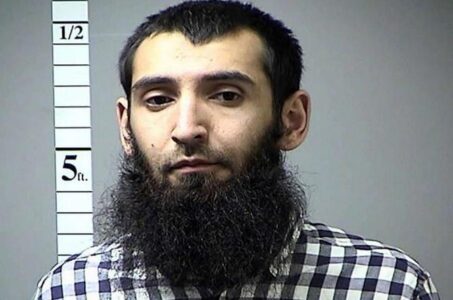
Terror suspect accused of killing 8 people on NYC bike path still believes in ISIS
Sayfullo Saipov, the man accused of using a rented truck to fatally strike eight people on a New York City bike path in 2017, became radicalized by watching ISIS videos online and still believes he had a religious obligation to carry out the attack, his court-appointed defense lawyer said in opening statements of his terrorism trial Monday.
“And as we sit here today, he still believes that, he still believes the ISIS messaging and he still believes it was God’s will that he do what he did,” Saipov’s attorney David Patton said.
Saipov has pleaded not guilty in federal court to 28 counts, including eight counts of murder, 18 counts of attempted murder and other terrorism charges in connection with the deadliest terror attack in New York since 9/11.
If convicted, he is eligible for the death penalty. The trial is the first federal death penalty case heard under President Joe Biden – who had previously pledged to eliminate the death penalty at the federal level.
The charges stem from the attack on Halloween 2017 in which Saipov allegedly drove a U-Haul truck into cyclists and pedestrians on Manhattan’s West Side bike path. He then crashed the vehicle into a school bus and left the truck while brandishing a pellet gun and paintball gun, authorities said at the time. He was shot by an NYPD officer and taken into custody, officials said.
He allegedly told investigators he planned the attack for about a year and was inspired by ISIS videos, according to a criminal complaint.
In court Monday, prosecutor Alexander Li recounted the attack, describing how Saipov created a scene of “destruction” and “horror” using a rented U-Haul truck as his weapon.
Afterward, Saipov was “eager” to tell federal agents about his terroristic plot, Li said.
“He told the FBI agents how he planned and practiced his attack. He told them that his goal was to kill as many people as possible. He told them that the leader of ISIS had called for attacks and the defendant responded,” Li said.
Saipov smiled at the memory of his attack during an interview with federal agents in the hospital, Li said. He also asked to display an ISIS flag in his hospital room at the time, according to the prosecutor.
Saipov still maintains his allegiance to ISIS, the prosecutor said. He’s told family members that he is a soldier of ISIS in recorded jail calls in the years since the attack, according to Li.
Defense acknowledges he carried out the attack
Patton, Saipov’s defense attorney, did not dispute that he committed the attack and focused his opening statements on Saipov’s motives and connections to ISIS.
The attorney called Saipov’s actions “senseless,” adding, “There is no excuse for what he did and we will not offer one to you.”
The defendant was inspired by ISIS, but the terrorist organization did not aid him in committing the attack, Patton said.
ISIS leaders claimed responsibility for Saipov’s attack two days after the incident, Patton acknowledged, but the defense attorney argued that the terrorist group historically has claimed responsibility for violent events that are not substantiated by authorities as perpetrated by ISIS.
“He did not expect to walk away from this attack and become a member of ISIS or any organization,” Patton said. “He expected to die.”
Saipov was not attached to ISIS in any meaningful way at the time of the attack, the public defender said.
Patton gave the jury a history of ISIS and its media operation and distribution network, calling the extremist group’s media efforts “sophisticated” and ahead of its time when Saipov was first inspired by its messaging.
“He did it because he had become immersed in a world of ISIS messaging online and social media in chat groups, hours and hours of audio and video material and other material. And he had become convinced that it was a religious obligation for him to commit a martyrdom attack,” Patton said.
Saipov became radicalized consuming extremist content during lengthy solo stints as a long-haul truck driver, his attorney said.
He grew up culturally Muslim in Uzbekistan but was not exposed to any significant amount of religious study, and his family members are not ISIS supporters, Patton said.
Saipov was in US on a diversity visa
Saipov came to the United States from Uzbekistan in 2010 and was living in New Jersey before the attack. He lived with his wife and three children and drove for Uber, according to officials.
He came to the US on a diversity immigrant visa, which allows people from countries with low recent immigration to apply for a visa and green card, according to the Department of Homeland Security. He later became a legal permanent resident, an NYPD official said.
Of the eight people killed in the attack, five were from Argentina, two were Americans, and one was from Belgium, police said.
The Argentinians were part of a group celebrating the 30th anniversary of their high school graduation in New York City.
Argentina’s Foreign Affairs Ministry identified them as Hernán Diego Mendoza, Diego Enrique Angelini, Alejandro Damián Pagnucco, Ariel Erlij and Hernán Ferruchi.
Nicholas Cleves, 23, from New York, and Darren Drake, 32, from New Milford, New Jersey, were the two Americans killed.
Ann-Laure Decadt, a 31-year-old Belgian woman, was also among those killed, according to a statement from her husband, Alexander Naessens. Decadt, a mother of two young sons, was on a trip to New York with her two sisters and her mother, Naessens said after the attack.
CNN’s Holly Yan, Dakin Andone, Nicole Chavez and Shimon Prokupecz contributed to this report.
Source: msn





